How Much Has The Climate Changed In The Last 10 Years
Every bit this hottest-on-record, godforsaken decade draws to a close, it'southward clear that global warming is no longer a problem for future generations but one that's already displacing communities, costing billions, and driving mass extinctions. And information technology'south worth asking: Where did the past 10 years get us?
The seven charts below brainstorm to hint at an answer to that question. Some of the changes they document, like the concentration of carbon dioxide in the atmosphere and the number of billion dollar disasters that occur each year, illustrate how little we did to reduce emissions and how unprepared the world is to deal with the warming we've already locked in. Fifty-fifty though more people believe in human-caused climate modify now than 10 years ago, a growing chasm in political partisanship makes it more hard than ever for Congress to laissez passer climate legislation.
But by other measures, nosotros might 1 twenty-four hour period expect back on the 2010s as a turning point in our civilization's approach to climate change. The growth of renewable energy and rapid retirement of coal-called-for power plants this decade illustrate that crucial changes to the world order are currently well underway.
1. Atmospheric carbon dioxide rose by about 25 parts per 1000000.
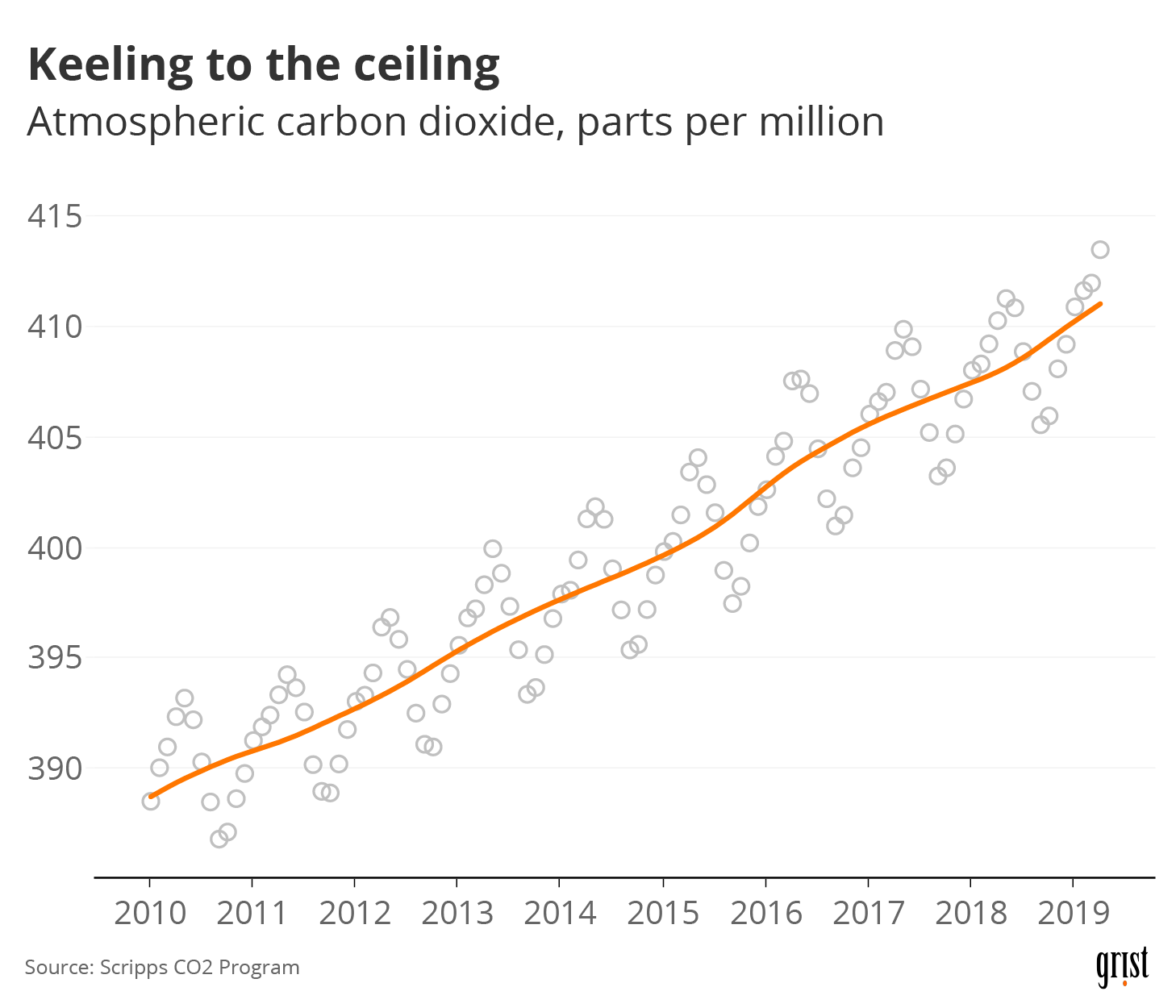
Clayton Aldern / Grist
Permit'south outset with the large picture, which is to say: the bad news. The concentration of carbon dioxide in the atmosphere has not only connected to ascent over the past x years, but it is also now ascent at a faster charge per unit than ever before.
In 2013, the famous atmospheric carbon monitoring station on Mauna Loa, first installed by Charles David Keeling in 1958, measured levels above 400 parts per million for the offset time ever. By 2016, that number became the almanac low. The world's atmosphere has not contained this much carbon dioxide in millions of years — since before Homo sapiens walked the earth. And unless we detect some way to suck carbon out of the atmosphere, the Keeling bend will not dip below 400 parts per meg again in your lifetime, your children's lifetime, or their children'south lifetime, considering carbon dioxide tin hang effectually in the atmosphere for hundreds of years.
The Intergovernmental Console on Climatic change has estimated that in guild to limit planetary warming to 1.five degrees, we can't let atmospheric CO2 concentrations rise above 430 parts per million. Based on current trends, nosotros only accept about another x years left to transform our energy organisation before nosotros blow correct past that number too.
2. Climate change got expensive.
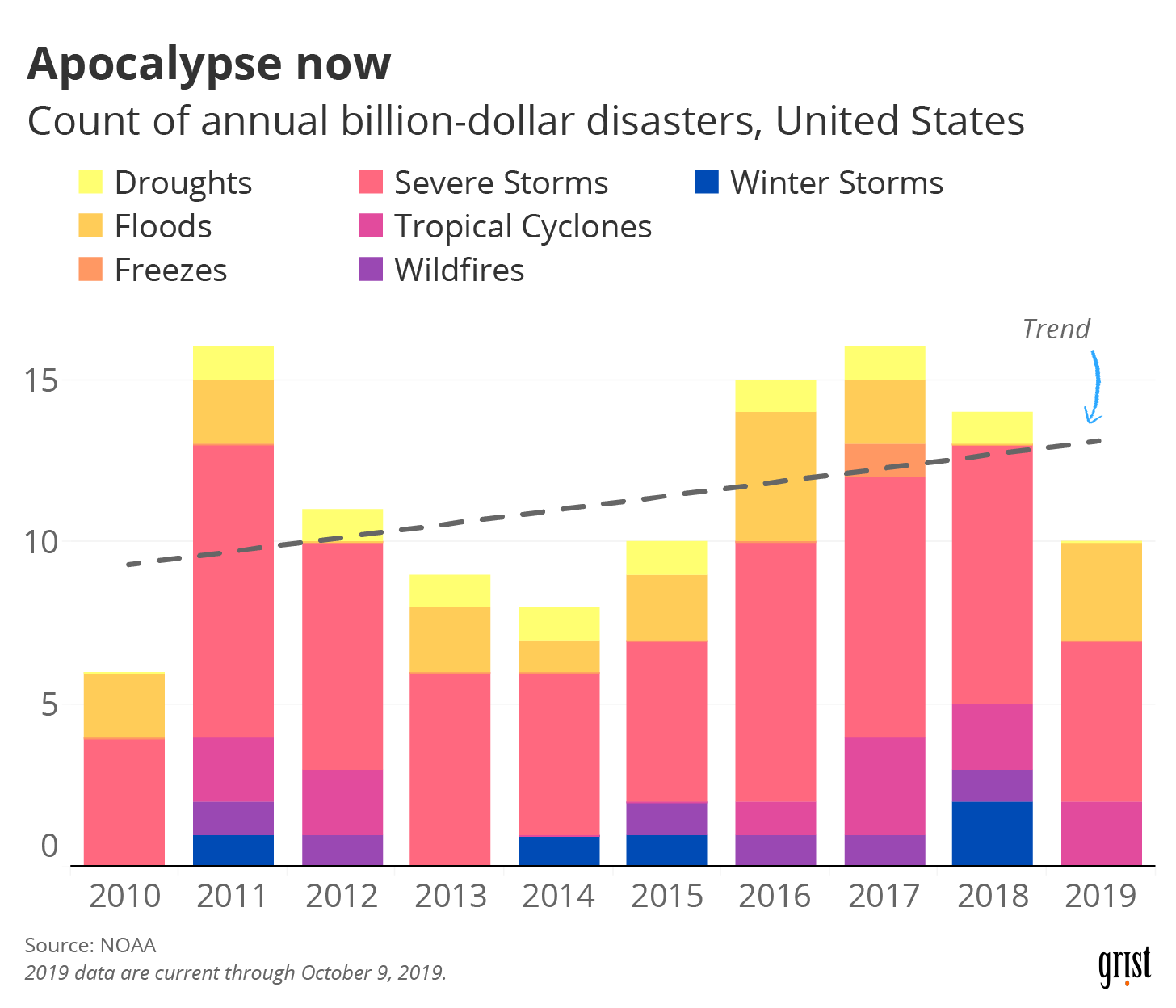
Clayton Aldern / Grist
One of the best-established consequences of global warming is that information technology makes natural disasters, like fires and floods, more frequent and severe. In the 2010s, the costs of this issue came into sharp focus equally billion-dollar disasters struck the United States again and again. Hurricanes Irene and Sandy pummeled the Northeast, Maria forever changed Puerto Rico, Florence shook up North Carolina, and Harvey drowned Houston, Texas only weeks before Irma sank Florida. Super Typhoon Yutu, the worst tempest to hit U.S. soil since 1935, wreaked havoc on the northern Mariana Islands in the Philippines. There was tape flooding in the Midwest and Californians were struck by some of the largest and most destructive fires the Golden Land has always seen.
If in that location'south an upside to whatever of this, information technology'south that these storms disrupted the status quo. The massive expense, devastation, and displacement they brought may be prompting people to question why these storms seem worse than e'er before, to consider moving to higher footing (or to Buffalo), or to demand adaptation and mitigation measures in their hometowns.
3. More than people accept the basic bounds that it'south getting hot and that it's our mistake.
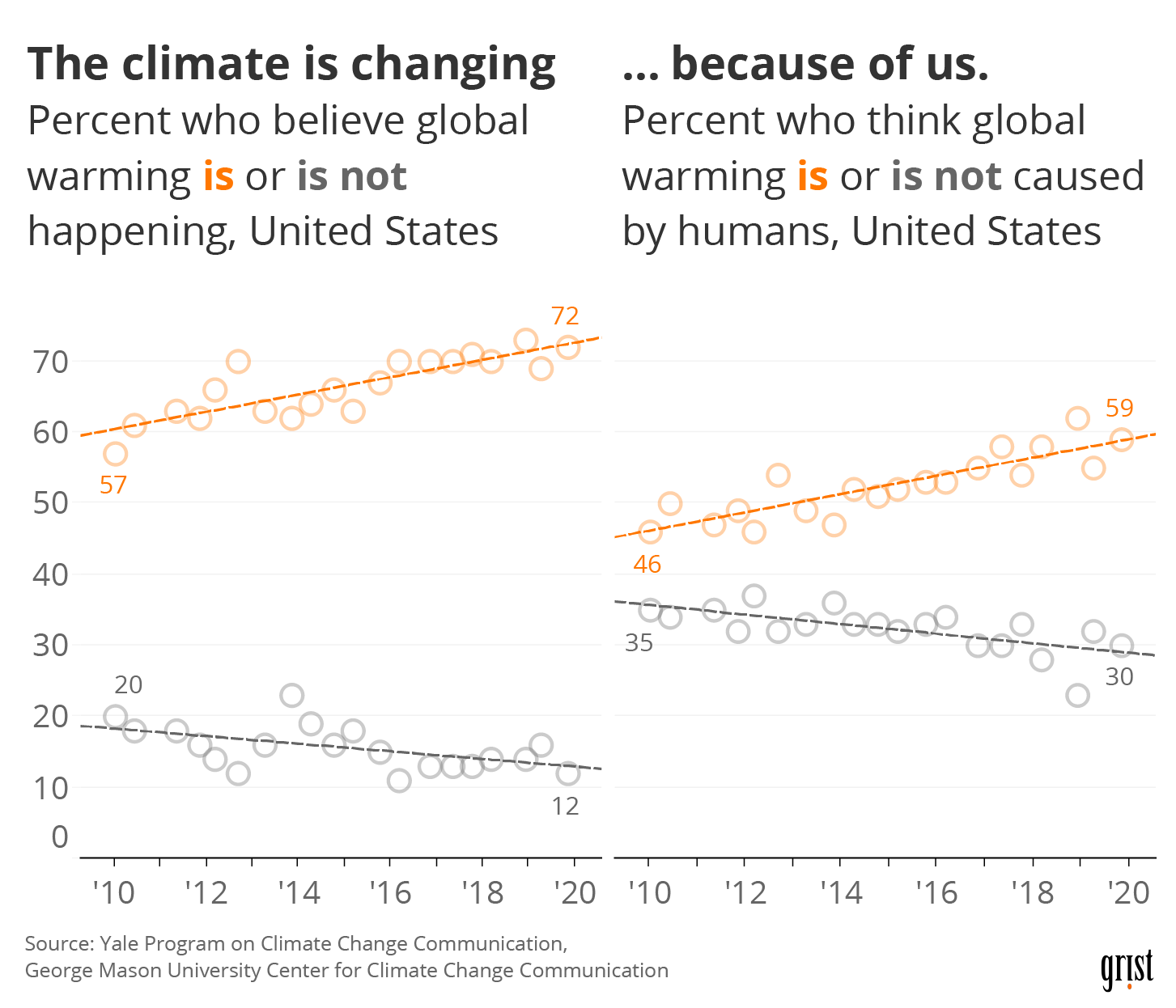
Clayton Aldern / Grist
When it comes to climate alter, at that place'southward plenty to argue about. Should we open new nuclear plants? Would a carbon tax work? Does cap and trade take a net benefit? But if there are two things that nobody should exist arguing about, they're the facts that the planet is getting hotter, and that information technology's because of human being action.
Among scientists, that score was settled a long time ago. But for some reason, the average Joe has taken a lot longer to come up around to the idea … some reason that probably has a lot to practise with the billions of dollars spent by fossil fuel companies to seed skepticism nigh the science of climate alter and then muddy the waters around what we should do about it. There will always be skeptics and conspiracy theorists, simply this decade, we've seen more and more than Americans come to accept the basics of climate science, which could translate into more than political will to take action in the 2020s.
4. But there's a widening partisan divide when it comes to worrying well-nigh the environment.
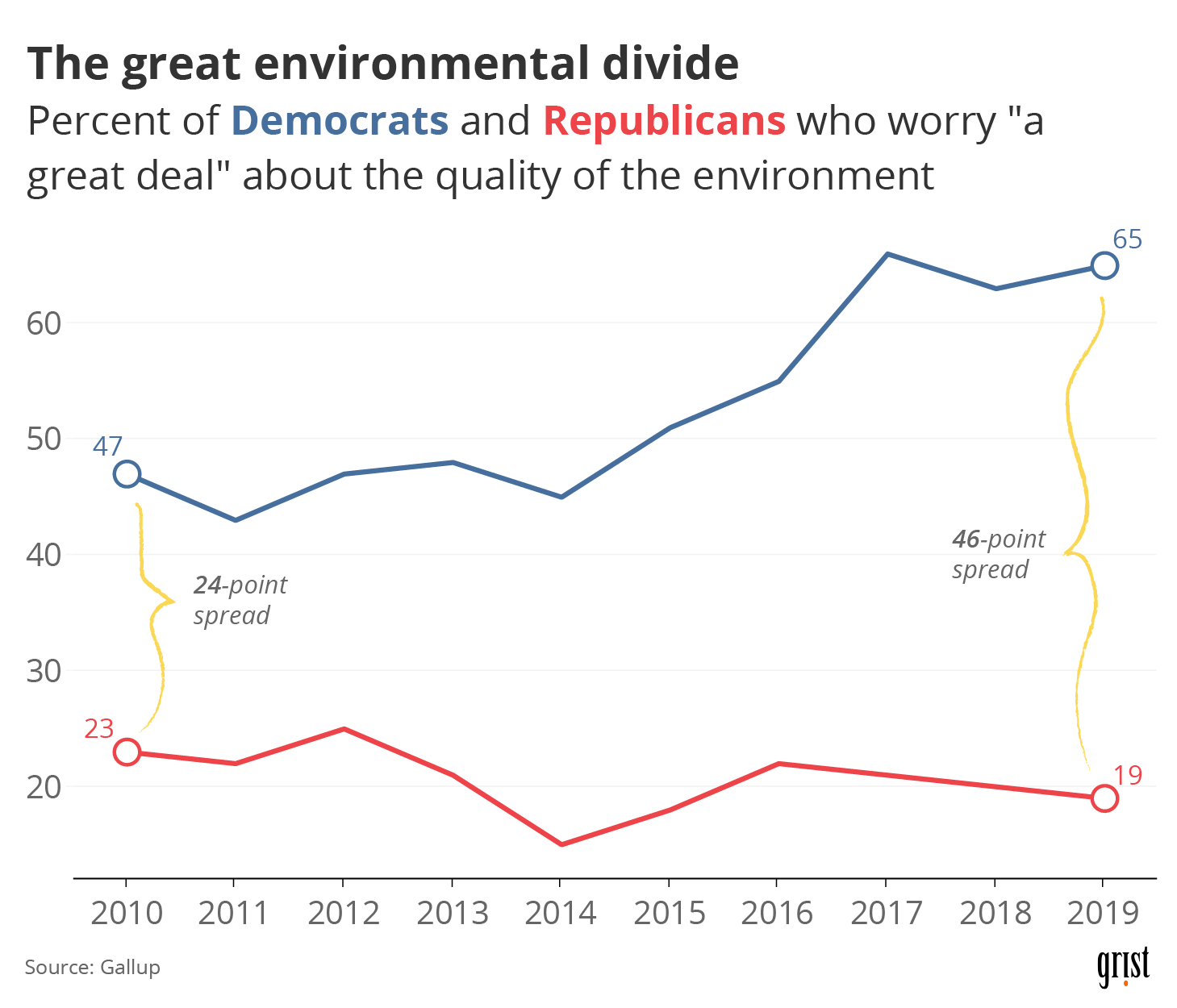
Clayton Aldern / Grist
In 2008, Nancy Pelosi and Newt Gingrich saturday on a couch together and proclaimed, "Our land must accept action to address climate alter." 3 years later, Gingrich would write off the bipartisan television spot as "probably the dumbest single thing I've washed in recent years." What happened?
The short answer is: polarization. Every bit audiences siloed themselves abroad in fortified partisan media towers and conservatives balked at the theoretical price tag of climate action — or came to see the climate move as a liberal ploy to usher in an era of big government — this decade saw the twisting of environmentalism writ large into a dramatically polarizing issue. Today, one'due south environmental positions in the United States are nearly as predictive of political party affiliation as ane'southward views on gun control and race.
With a new decade earlier us, a U.S. presidential election on the horizon, and always-increasing urgency to act on climate change, the current hyperpolarization of the result promises to bear witness a challenge to the collective action we'll need.
5. Coal continued its death spiral.

Clayton Aldern / Grist
Even though at that place was no slowing of the Keeling curve'due south relentless climb this decade, the mix of sources producing all of that atmospheric carbon on the ground changed quite a flake. Coal-fired power plants, easily the nigh polluting and carbon-intensive source of energy at our disposal, saw a major reject this decade. From 2000 to 2009, the full generating capacity of coal-fired power plants taken offline in the United States was six gigawatts. From 2010 to 2019, that number jumped to fourscore gigawatts — enough to power about 43 1000000 homes.
Coal'due south downfall is complicated, owing more than to the fracking smash and the rise of a cheap alternative in natural gas than to environmental regulations or clean energy policy. In 2016, natural gas surpassed coal as the number ane source of electricity generation in the U.South. for the offset time. Called-for natural gas emits most half equally much carbon dioxide as coal, but those gains are diminished by the unknown quantity of methane leaking from other parts of the natural gas lifecycle.
Coal's down trend was not only a U.Southward. phenomenon. This twelvemonth coal was on rail to see its biggest decline yet effectually the globe. Simply again, information technology'south complicated. Other recent reports accept found that coal's death spiral may in fact look more like an arrow pointing to Asia. Coal capacity in China and Republic of india grew over the by 10 years. The decisions these 2 countries make most their energy mix in the next decade will determine how much nosotros are able to limit overall warming.
vi. Solar skyrocketed, but fossil fuels nonetheless dominate.
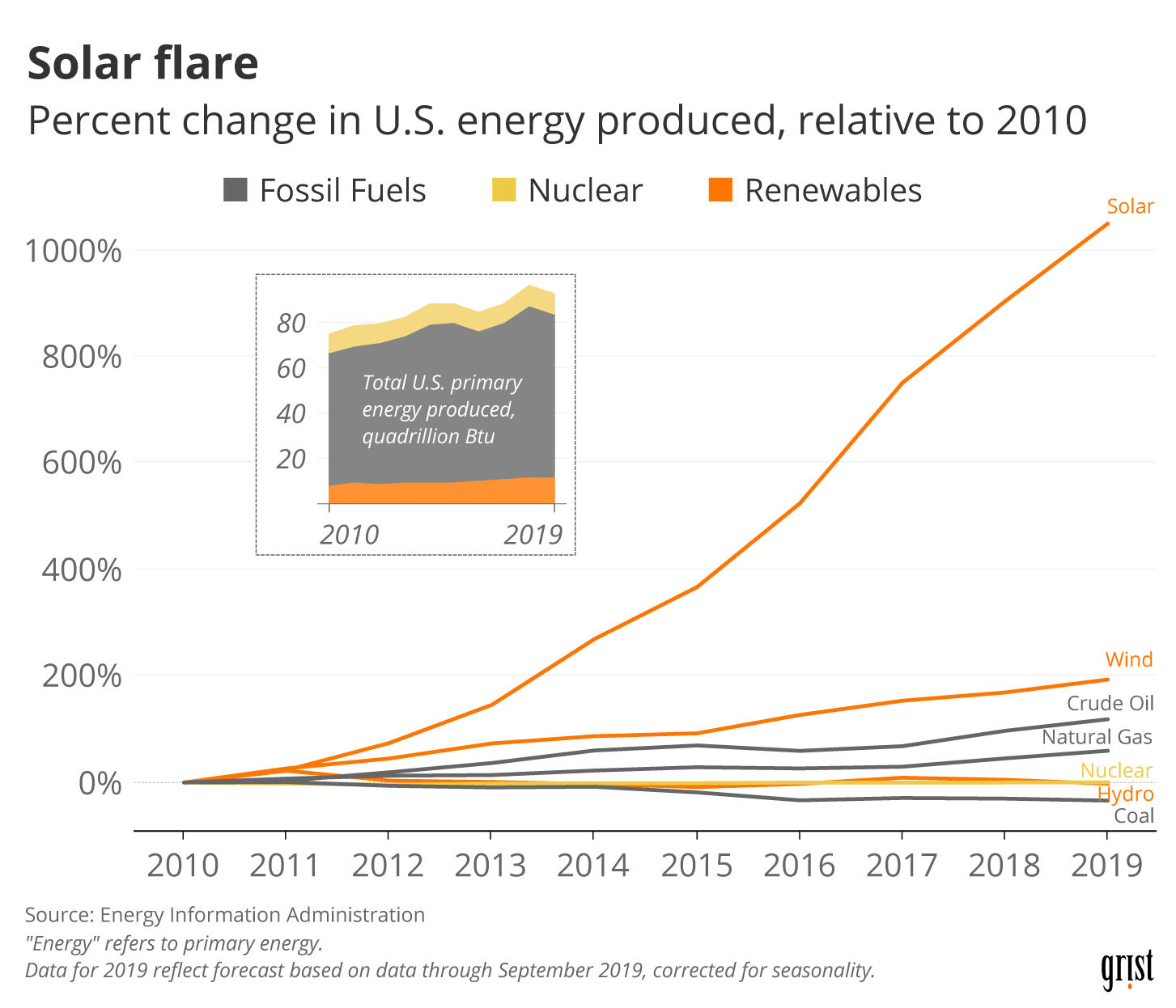
Clayton Aldern / Grist
Despite coal's rapid pass up, fossil fuels continued to make up the vast majority of the U.Southward.'due south free energy mix this decade. Only even though renewables didn't make much of a dent in the overall energy mix — they still only fabricated up about 11 per centum of primary energy production in 2018 — a shift is clearly underway. Solar energy production increased past about 900 percent between 2010 and 2018, illustrating in stark terms the expansion of the U.S. solar industry. This figure is only expected to abound as analysts tabulate the end-of-decade values. Wind free energy production, as well, is estimated to take tripled since 2010.
Proceed in mind that merely about 38 percent of the total raw free energy produced ends upwardly feeding into the electrical filigree — the rest goes to other uses. In 2018, for example, almost 70 percent of primary petroleum free energy was used in the transportation sector, where it accounted for more than 90 per centum of the sector's free energy consumption. Only near 1 percentage of primary energy used in the electric power sector comes from oil. Nuclear power, on the other hand, exists wholly for the purpose of electricity generation. The country's free energy mix is a reminder that decarbonization means more just greening our electric grid.
7. While coal flatlined, the price of renewables dropped precipitously.
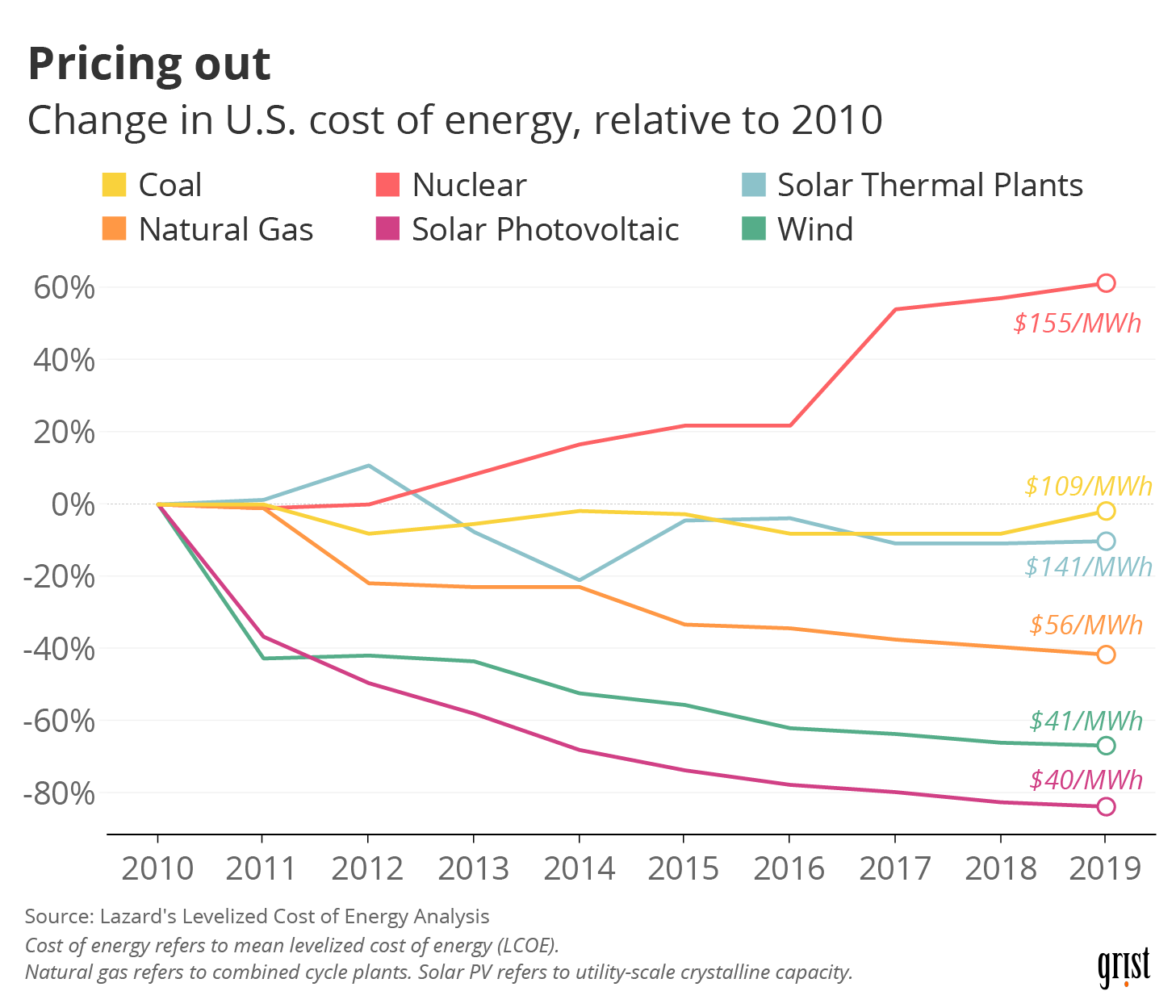
Clayton Aldern / Grist
Natural gas wasn't the just energy source that got cheaper this decade. Renewables also became more competitive on price. The cost of installing photovoltaic panels, whether for a rooftop assortment or a commercial-calibration solar subcontract, dropped by well-nigh $5 per kilowatt since 2010. That'due south thank you in part to the 30 percentage federal solar investment tax credit (which is set to brainstorm phasing out presently) simply besides to the slew of cities and states around the country that take passed renewable energy goals and created their own incentives.
As solar panels became cheaper and more than efficient, Americans on both sides of the aisle furiously added them to their roofs, local governments set them up along the side of the highway, and farmers put them out to pasture. Solar panels still only brand up a paltry 1.four percent of our total electricity generation mix. Simply if current of air and solar continue at their electric current rate of growth, the U.S. has a shot at 100 pct renewable free energy by 2050.
Source: https://grist.org/climate/we-broke-down-the-last-decade-of-climate-change-in-7-charts/
Posted by: hectorrusequithe.blogspot.com

0 Response to "How Much Has The Climate Changed In The Last 10 Years"
Post a Comment